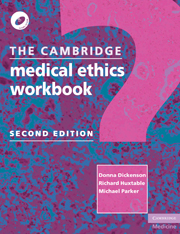Book contents
- Frontmatter
- Contents
- List of cases
- List of papers
- Preface to the second edition
- Preface to the first edition
- Cases in medical ethics and law: an interactive tutorial
- 1 Death and dying: decisions at the end of life
- 2 Reproduction: decisions at the start of life
- 3 Genetics: information, access and ownership
- 4 Medical research: participation and protection
- 5 Mental health: consent, competence and caring
- 6 Long-term care: autonomy, ageing and dependence
- 7 Children and young people: conflicting responsibilities
- 8 Resource allocation: justice, markets and rationing
- 9 Thinking about ethics: autonomy and patient choice
- Appendix 1 Study guide for teachers
- Appendix 2 Using keywords to explore this book
- Bibliography
- Index
Appendix 1 - Study guide for teachers
- Frontmatter
- Contents
- List of cases
- List of papers
- Preface to the second edition
- Preface to the first edition
- Cases in medical ethics and law: an interactive tutorial
- 1 Death and dying: decisions at the end of life
- 2 Reproduction: decisions at the start of life
- 3 Genetics: information, access and ownership
- 4 Medical research: participation and protection
- 5 Mental health: consent, competence and caring
- 6 Long-term care: autonomy, ageing and dependence
- 7 Children and young people: conflicting responsibilities
- 8 Resource allocation: justice, markets and rationing
- 9 Thinking about ethics: autonomy and patient choice
- Appendix 1 Study guide for teachers
- Appendix 2 Using keywords to explore this book
- Bibliography
- Index
Summary
Each of the chapters in this workbook is intended to be a flexible educational resource, and we would encourage both learners and teachers to use the materials in a way which best suits their requirements. In some cases this might mean working through an entire chapter, but more often it might mean using a case study and the related activities as an educational resource to be used in conjunction with other materials. The chapters and the activities within them are intended to be used in a variety of ways at different points in the medical or nursing curriculum or for post-qualifying training; they are equally suitable for use as distance learning materials for self-study.
We aim to present a kind of medical ethics and a way of teaching it which we believe doctors and nurses will find highly relevant to their everyday practice. Although we sometimes refer to the ‘big’ cases and issues, as evidence of legal positions, for example, we concentrate on ‘everyday ethics’ by beginning each chapter with a very ordinary and typical sort of case. So we answer the question ‘why study medical ethics?’ by beginning from examples which will resonate with practitioners, we hope. The headline topics are important, demonstrating that the issues of medical ethics are of widespread interest to the population as a whole – of which healthcare practitioners are of course a part.
- Type
- Chapter
- Information
- The Cambridge Medical Ethics Workbook , pp. 215 - 220Publisher: Cambridge University PressPrint publication year: 2010



